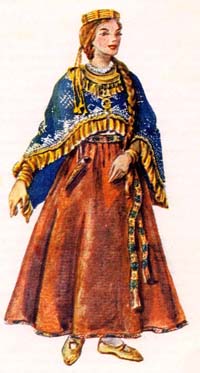Background
Traditional costumes reflect specific ethnic preferences and tastes expressed in the forms, colours and ornaments that people wear. Latvians tend to use dark grey, brown and green shades embroidered with colourful symbols and patterns influenced by ancient pagan beliefs, although some regions favour brighter colours than others. Over the centuries the people have lived an agrarian lifestyle, most of their time spent tending their crops and animals. They kept sheep for wool to weave and made linen from flax. Much of the wool was woven in the natural colours of black, brown and creamy white but wool was also dyed using leaves, bark, flowers and roots, before manufactured dyes were introduced. For festive occasions white was the predominant colour, being associated with purity, goodness and enlightenment. Red, a colour associated with fire, blood and life, has been used to decorate linen garments, such as aprons, head-coverings and shirts. Black, on the other hand, has always been regarded as the colour of the gentry and so was not used in national costumes or any farmersí garments until the second half of the nineteenth century, but still not as a dominant colour.
|
This example from the Latgale region of Latvia is of one of the earliest known costumes. The shawl was woven in a herring-bone pattern with a colourful hem depicting triangles along the top edge and diamonds along the bottom. A multi-coloured fringe was attached the side edges in blue, red and brown wool. Little bronze rings were used to form patterns on the shawl in the fire cross design and the shawl is fastened in front with a horse-shoe shaped broach.
The girl's coronet is made if six rows of spirals joined by links, with little chains hanging down the back. A bronze band with little pendants was worn around the neck and a chain-shaped ornament on the breast. The skirt is of brown wool with a coloured edge along hem and waist. The blouse is white linen. |
|
National costumes worn on festive occasions in Latvia have survived because they have been handed down from generation to generation as colourful adornments and treasured heirlooms. While preserving and continuing the traditions of a region, each woman created a distinctive costume for herself or her man. Apparently Latvia falls into five ethnographic regions: Kurzeme, Vidzeme, Zemgale, Latgale, Augszeme, their distinctions reaching as far back as the XVII and XIX centuries. Regional borders were not strictly marked and a certain cultural interchange did exist as well as the effect of wars, invasions and foreign occupations.
As long as materials found in the region were used, the national costumes retained their distinctive designs. Home-made costumes for daily wear preserved traditional features longer than did festive costumes, which were more susceptible to external influences. Exceptions were some regions in Kurzeme like Nica, Rucava and Alsunga, where festive costumes remained unchanged until the mid-twentieth century. Regional variations are most pronounced in women's clothing: the cut and the colour-scheme, embroidery technique and composition, adornment of belts, socks and mittens. Headgear, outdoor clothes and footwear did not vary as much.

